Dental Bridges – Fairfax, VA
Bridge gaps in your smile with dental bridges
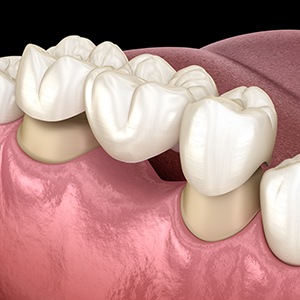
Dental bridges were designed to close gaps in your arches caused by missing teeth. They work by anchoring crowns to two healthy “abutment” teeth and filling in the empty spaces between them with up to four prosthetic teeth. Dental bridges both look and feel natural, and due to their strength can be used to eat a variety of healthy foods. Best of all, because of its realistic appearance, nobody will ever need to know your bridge is a prosthetic!
Why Choose Fairfax Dental Group for Dental Bridges?
- Decades of experience
- Durable, natural-looking restorations
- Dental insurance welcome
What is a Dental Bridge?
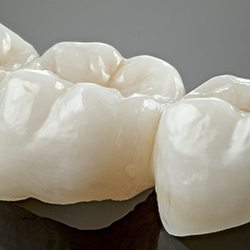
A dental bridge is bridge is a prosthetic tooth replacement that can restore up to four consecutive missing teeth at once, as long as they’re surrounded by two healthy teeth. They can be made from a variety of natural-looking materials, but your dentist can discuss which type is best for your individual mouth during your consultation.
Types of Dental Bridges
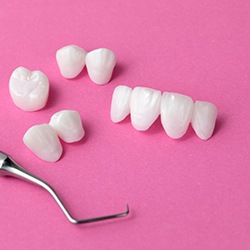
When you’re missing permanent teeth, it can cause myriad problems, including difficulties speaking and chewing properly. Replacing lost teeth with the help of a dental bridge can not only restore the appearance of your smile, but it can also eliminate these problems and even boost your self-esteem. Your dentist can help you determine which type of bridge is best for you, so schedule a consultation today to discuss your options.
Traditional Dental Bridges
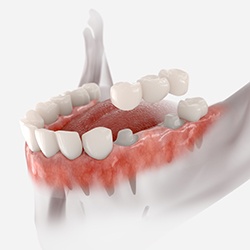
Traditional dental bridges work by anchoring your prosthetic teeth onto two healthy teeth surrounding the gaps in your smile. To get a traditional bridge, you must have two healthy teeth that are strong enough to support it. With proper care and use, your bridge can restore the appearance and function of your teeth for ten or more years.
Implant Bridges
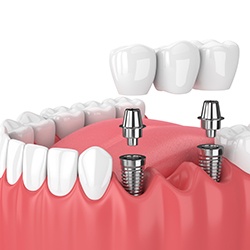
Instead of relying on healthy teeth to anchor your bridge to your arch, implant bridges are secured to your jaw via permanent dental implants. Because your implant bridge can replace several teeth in one prosthetic, you may be able to avoid getting multiple individual dental implants which can often be more expensive.
The Benefits of Getting a Dental Bridge

Though missing permanent teeth may only seem like a cosmetic issue, the truth is that dental bridges can prevent several oral and overall health problems, including:
- Teeth shifting into misalignment
- Low self-esteem / self-confidence
- Problems chewing
- Difficulties speaking clearly
- Jawbone deterioration
- Increased risk of other oral health problems
If you’re missing one or more consecutive teeth and would like to restore your smile with a dental bridge, schedule a consultation with Fairfax Dental Group today, and let us help you bridge the gap to a healthier, happier mouth!
Dental Bridges FAQs
Can You Take a Dental Bridge Out?
Once it’s placed, you can’t take your dental bridge out yourself. Only a qualified dentist (or a similarly qualified professional) can safely remove it.
This fact stems from the design of dental bridges. Unlike other restorations, these kinds consist of crowns fused to either side of a pontic (i.e., an artificial tooth). That means a dental bridge is cemented to your nearby natural teeth or “abutments” to remain stable. If you want it removed, you’ll need your dentist to perform the removal process; attempting it yourself can harm your smile.
How Many Teeth Can a Dental Bridge Replace?
Well-made dental bridges can replace up to four missing adjacent teeth. That said, most dentists use them to replace only one or two at most.
The issue is that dental bridges lose stability as they extend. Once they reach far out, they’re more likely to fall apart and ruin a patient’s treatment results. (This risk is pretty high when the teeth supporting a bridge aren’t strong or healthy.) It’s thus not advisable to have a dental bridge replace three or four teeth.
Of course, you could minimize this problem with an implant bridge. This kind uses dental implants for security instead of abutments, so it’s very unlikely to fail.
Do Dental Bridges Look Natural?
Rest assured that today’s dental bridges look quite natural. Thanks to modern methods and materials, they can blend seamlessly with any patient’s adjacent teeth!
For starters, note that many metal-free bridges are made of tooth-colored materials. These include ceramic, special porcelains, zirconia, and more. Through such substances, a dental bridge color-matches nearby teeth and looks just like the rest of your smile.
Dental bridges are also secured to your mouth with special cement and crowns. As a result, there’s very little risk of your own prosthetic falling out. The bridge should remain secure and won’t “pop off’ unexpectedly.
Are Dental Bridges Safe?
As long as it’s placed by a qualified dentist, a dental bridge is perfectly safe. The device won’t do any harm to your nearby natural teeth, your gums, or any other part of your smile.
Our own office only uses ceramic and zirconia in its dental bridges. Such materials contain zero toxins, so you won’t need to worry about any potential poisoning. Some patients may experience adverse reactions to dental porcelain, but this is an extremely rare outcome. You’re almost sure to avoid such an effect.
Of course, please call us if your gums experience irritation, redness, or swelling near your dental bridge. These symptoms may indicate you’re having an allergic reaction.
Can Dental Bridges Get Cavities?
It is impossible for a dental bridge itself to get a cavity. However, the natural teeth that support it can. Food debris could become trapped beneath the pontics or in the space where the crowns meet the gums, attracting harmful bacteria that may result in cavities or gum infections. This is more likely to occur with poor oral hygiene. It’s important that you maintain an excellent oral hygiene routine, including cleaning beneath and around the bridge every day.
Are Dental Bridges Covered by Insurance?
Yes, dental bridges usually receive partial coverage. However, the level of coverage can vary between providers and plans. Most dental plans consider bridges to be a major procedure, so they typically cover about 40% to 50% of the cost. This is if you have met your deductible and not exceeded your maximum.
How Soon Can You Get a Bridge After a Tooth Extraction?
After a tooth extraction, your gums and jawbone need time to heal. If a dental bridge is placed too soon, it may not fit properly. The duration of the healing process can vary based on the state of your oral health, but for most people, it takes between eight and twelve weeks. If you’re getting an implant bridge, it may be possible to have implants placed right away after your extraction, but this depends on your unique case. Your dentist will be able to give you a more specific timeline for getting your dental bridge.
Is a Partial Denture the Same as a Bridge?
No. Partial dentures are sometimes referred to as removable bridges, but they are not the same thing. A bridge is designed to remain in place for many years and can only be removed by a dentist, but a patient can remove their partial denture at any time. The other main difference is that dental bridges only replace missing teeth if they are consecutive. Partial dentures are able to replace several teeth at various points along an arch.

